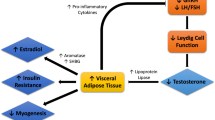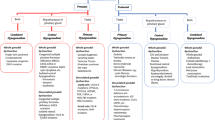Abstract
Testosterone deficiency syndrome (TDS) refers to the clinical signs and symptoms that result from an abnormally low testosterone level. Men with 'classic' hypogonadism can have unequivocally low testosterone levels and typical symptoms and signs. By contrast, the age-related decline of testosterone levels can be responsible for ambiguous clinical pictures, which can potentially be misinterpreted as part of the aging process or depression. Nevertheless, this decline can have detrimental effects on quality of life and on the function of multiple organ systems. TDS is underdiagnosed—its overall prevalence varies from 6% to 9.5% in community-dwelling men aged 40–70 years, and rises to 15–30% in diabetic or obese men—and undertreated; less than 10% of men with TDS receive treatment. This Review highlights potential pitfalls in the diagnosis of both clinical and biochemical components of TDS.
Key Points
-
Symptoms and signs of testosterone deficiency syndrome (TDS) should be present simultaneously with a consistent, abnormally low, testosterone level for the diagnosis of TDS to be made
-
The clinical picture is usually typical in young men whereas it is usually less clear-cut in older men, because of their slow decline in testosterone levels
-
Men with sexual dysfunction, low physical activity, abdominal obesity, loss of muscle mass and strength, diabetes or metabolic syndrome should be screened for TDS
-
Low testosterone levels must be demonstrated in at least in two morning serum samples taken at an interval of 1–2 weeks, with measurement of serum follicle-stimulating hormone and luteinizing hormone levels to distinguish between primary (testicular) and secondary (hypothalamic–pituitary) hypogonadism
-
The overall prevalence of TDS varies from 6% to 9.5% in community-dwelling men aged 40–70 years, and rises to 15–30% in diabetic or obese men with or without metabolic syndrome
-
Comorbid diseases and drug interactions must be excluded before considering a diagnosis of TDS
This is a preview of subscription content, access via your institution
Access options
Subscribe to this journal
Receive 12 print issues and online access
$209.00 per year
only $17.42 per issue
Buy this article
- Purchase on Springer Link
- Instant access to full article PDF
Prices may be subject to local taxes which are calculated during checkout


Similar content being viewed by others
References
Wang C et al. (2004) Long-term testosterone gel (AndroGel) treatment maintains beneficial effects on sexual function and mood, lean and fat mass, and bone mineral density in hypogonadal men. J Clin Endocrinol Metab 89: 2085–2098
Kelleher S et al. (2004) Blood testosterone threshold for androgen deficiency symptoms. J Clin Endocrinol Metab 89: 3813–3817
Nieschlag E et al. (2005) Investigation, treatment and monitoring of late-onset hypogonadism in males. ISA, ISSAM, and EAU recommendations. Eur Urol 48: 1–4
Maggi M et al. (2007) The burden of testosterone deficiency syndrome in adult men: economic and quality-of-life impact. J Sex Med 4 (Pt 1): 1056–1069
Kupelian V et al. (2006) Low sex hormone-binding globulin, total testosterone, and symptomatic androgen deficiency are associated with development of the metabolic syndrome in nonobese men. J Clin Endocrinol Metab 91: 843–850
Bhasin S et al. (2006) Testosterone therapy in adult men with androgen deficiency syndromes: an Endocrine Society clinical practice guideline. J Clin Endocrinol Metab 91: 1995–2010
Morales A et al. (2006) Testosterone deficiency syndrome (TDS) needs to be named appropriately—the importance of accurate terminology. Eur Urol 50: 407–409
Kaufman JM et al. (2005) The decline of androgen levels in elderly men and its clinical and therapeutic implications. Endocr Rev 26: 833–876
Arnott J (2006) A clinically relevant approach to defining the prevalence of late-onset hypogonadism in men from the general population [abstract #OR5-4]. Presented at the 88th Annual Meeting of the Endocrine Society: 2006 June 24–28, Boston, MA
Morley JE et al. (2005) Frailty and the aging male. Aging Male 8: 135–140
Christ-Crain M et al. (2004) Is there a clinical relevance of partial androgen deficiency of the aging male? J Urol 172: 624–627
Morley JE et al. (2006) Comparison of screening questionnaires for the diagnosis of hypogonadism. Maturitas 53: 424–429
Heinemann LA et al. (1999) A new “Aging Male's Symptoms” (AMS) rating scale. Aging Male 2: 105–114
T'Sjoen G et al. (2004) Perception of males' aging symptoms, health and well-being in elderly community-dwelling men is not related to circulating androgen levels. Psychoneuroendocrinology 29: 201–214
Smith KW et al. (2000) Construction and field validation of a self-administered screener for testosterone deficiency (hypogonadism) in ageing men. Clin Endocrinol (Oxf) 53: 703–711
Corona G et al. (2006) ANDROTEST: a structured interview for the screening of hypogonadism in patients with sexual dysfunction. J Sex Med 3: 706–715
Delhez M et al. (2003) Andropause and psychopathology: minor symptoms rather than pathological ones. Psychoneuroendocrinology 28: 863–874
Morley JE et al. (1979) Gonadal dysfunction in systemic disorders. Metabolism 28: 1051–1073
Isidori AM et al. (2005) Risk factors for androgen decline in older males: lifestyle, chronic diseases and drugs. J Endocrinol Invest 28: 14–22
Hammes A et al. (2005) Role of endocytosis in cellular uptake of sex steroids. Cell 122: 751–762
McLachlan RI et al. (2004) Defining the prevalence and incidence of androgen deficiency in aging men: where are the goal posts? J Clin Endocrinol Metab 89: 5916–5919
Morley JE et al. (1997) Longitudinal changes in testosterone, luteinizing hormone and follicle-stimulating hormone in healthy older men. Metabolism 46: 410–413
Harman SM et al. (2001) Longitudinal effects of aging on serum total and free testosterone levels in healthy men. Baltimore Longitudinal Study of Aging. J Clin Endocrinol Metab 86: 724–731
Vermeulen A (2001) Androgen replacement therapy in the aging male—a critical evaluation. J Clin Endocrinol Metab 86: 2380–2390
Feldman HA et al. (2002) Age trends in the level of serum testosterone and other hormones in middle-aged men: longitudinal results from the Massachusetts Male Aging Study. J Clin Endocrinol Metab 87: 589–598
Resko JA et al. (1966) Diurnal testosterone levels in peripheral plasma of human male subjects. J Clin Endocrinol Metab 26: 573–576
Bremner WJ et al. (1983) Loss of circadian rhythmicity in blood testosterone levels with aging in normal men. J Clin Endocrinol Metab 56: 1278–1281
Diver MJ et al. (2003) Diurnal rhythms of serum total, free and bioavailable testosterone and of SHBG in middle-aged men compared with those in young men. Clin Endocrinol (Oxf) 58: 710–717
Mulligan T et al. (2006) Prevalence of hypogonadism in males aged at least 45 years: the HIM study. Int J Clin Pract 60: 762–769
Crawford ED et al. (2006) Diurnal serum testosterone variation in aging men: cross-sectional analysis from a large national screening program reveals only a modest decline beginning in the mid-afternoon [abstract #1324]. J Urol 175: 426
Vermeulen A et al. (1992) Representativeness of a single point plasma testosterone level for the long term hormonal milieu in men. J Clin Endocrinol Metab 74: 939–942
Wang C et al. (2004) Measurement of total serum testosterone in adult men: comparison of current laboratory methods versus liquid chromatography–tandem mass spectrometry. J Clin Endocrinol Metab 89: 534–543
Taieb J et al. (2003) Testosterone measured by 10 immunoassays and by isotope-dilution gas chromatography–mass spectrometry in sera from 116 men, women, and children. Clin Chem 49: 1381–1395
Fiers T et al. Free & Bioavailable Testosterone Calculator [http://www.issam.ch/freetesto.htm] (Accessed 29 May 2008)
Klee GG and Heser DW (2000) Techniques to measure testosterone in the elderly. Mayo Clin Proc 75 (Suppl): S19–S25
Collier CP et al. (2007) Functional testosterone: biochemical assessment of hypogonadism in men—report from a multidisciplinary workshop hosted by the Ontario Society of Clinical Chemists. Aging Male 10: 211–216
Institute of Medicine Committee on Assessing the Need for Clinical Trials of Testosterone Replacement Therapy (2003) Testosterone and aging: clinical research directions. (Eds Liverman CT and Blazer DG) Washington DC: The National Academies Press
Zitzmann M et al. (2006) Association of specific symptoms and metabolic risks with serum testosterone in older men. J Clin Endocrinol Metab 91: 4335–4343
Zitzmann M et al. (2007) Androgen receptor gene CAG repeat length and body mass index modulate the safety of long-term intramuscular testosterone undecanoate therapy in hypogonadal men. J Clin Endocrinol Metab 92: 3844–3853
Lackner JE et al. (2007) Hypogonadism and androgen deficiency symptoms in testicular cancer survivors. Urology 69: 754–758
American Association of Clinical Endocrinologists (2002) Medical guidelines for clinical practice for the evaluation and treatment of hypogonadism in adult males—2002 update. Endocr Pract 8: 440–456
Park K et al. (2005) Risk factors in predicting a poor response to sildenafil citrate in elderly men with erectile dysfunction. BJU Int 95: 366–370
Laughlin GA et al. (2008) Low serum testosterone and mortality in older men. J Clin Endocrinol Metab 93: 68–75
Conway AJ et al. (2000) Use, misuse and abuse of androgens. The Endocrine Society of Australia consensus guidelines for androgen prescribing. Med J Aust 172: 220–224
Gheorghiu I et al. (2005) When is bioavailable testosterone a redundant test in the diagnosis of hypogonadism in men? Clin Biochem 38: 813–818
Morris PD et al. (2004) A mathematical comparison of techniques to predict biologically available testosterone in a cohort of 1,072 men. Eur J Endocrinol 151: 241–249
Tan RS (2002) Andropause: introducing the concept of 'relative hypogonadism' in aging males. Int J Impot Res 14: 319
Tenover JS (1994) Androgen administration to aging men. Endocrinol Metab Clin North Am 23: 877–892
Araujo AB et al. (2007) Prevalence of symptomatic androgen deficiency in men. J Clin Endocrinol Metab 92: 4241–4247
Litman HJ et al. (2006) Serum androgen levels in black, Hispanic, and white men. J Clin Endocrinol Metab 91: 4326–4334
Morley JE et al. (2003) Andropause: an old concept in new clothing. Clin Geriatr Med 19: 507–528
Hijazi RA et al. (2005) Andropause: is androgen replacement therapy indicated for the aging male? Annu Rev Med 56: 117–137
Araujo AB et al. (2004) Prevalence and incidence of androgen deficiency in middle-aged and older men: estimates from the Massachusetts Male Aging Study. J Clin Endocrinol Metab 89: 5920–5926
Bojesen A et al. (2003) Prenatal and postnatal prevalence of Klinefelter syndrome: a national registry study. J Clin Endocrinol Metab 88: 622–626
Abramsky L et al. (1997) 47,XXY (Klinefelter syndrome) and 47,XYY: estimated rates of and indication for postnatal diagnosis with implications for prenatal counseling. Prenat Diagn 17: 363–368
Daniell HW et al. (2001) Hypogonadism following prostate-bed radiation therapy for prostate carcinoma. Cancer 91: 1889–1895
Wong SY et al. (2006) Prevalence of and risk factors for androgen deficiency in middle-aged men in Hong Kong. Metabolism 55: 1488–1494
Kapoor D et al. (2007) Clinical and biochemical assessment of hypogonadism in men with type 2 diabetes: correlations with bioavailable testosterone and visceral adiposity. Diabetes Care 30: 911–917
Allan CA et al. (2006) The association between obesity and the diagnosis of androgen deficiency in symptomatic ageing men. Med J Aust 185: 424–427
Saely CH et al. (2005) The metabolic syndrome, insulin resistance, and cardiovascular risk in diabetic and nondiabetic patients. J Clin Endocrinol Metab 90: 5698–5703
Muller M et al. (2005) Endogenous sex hormones and metabolic syndrome in aging men. J Clin Endocrinol Metab 90: 2618–2623
Author information
Authors and Affiliations
Corresponding author
Ethics declarations
Competing interests
JL Tostain declared that he has acted as a consultant and received speaker's honoraria from Pierre Fabre Medicament.
F Blanc declared no competing interests.
Rights and permissions
About this article
Cite this article
Tostain, J., Blanc, F. Testosterone deficiency: a common, unrecognized syndrome. Nat Rev Urol 5, 388–396 (2008). https://doi.org/10.1038/ncpuro1167
Received:
Accepted:
Issue Date:
DOI: https://doi.org/10.1038/ncpuro1167
This article is cited by
-
Intramuscularly injected long-acting testosterone-cholesterol prodrug suspension with three different particle sizes: extended in vitro release and enhanced in vivo safety
Drug Delivery and Translational Research (2023)
-
A reliable electrochemical approach for detection of testosterone with CuO-doped CeO2 nanocomposites-coated glassy carbon electrode
Journal of Materials Science: Materials in Electronics (2021)
-
Clinically occult prostate cancer cases may distort the effect of testosterone replacement therapy on risk of PCa
World Journal of Urology (2019)
-
Natural course of hypogonadism diagnosed during hospitalization in aged male patients
Endocrine (2015)
-
Hypogonadism in aged hospitalized male patients: prevalence and clinical outcome
Journal of Endocrinological Investigation (2014)



